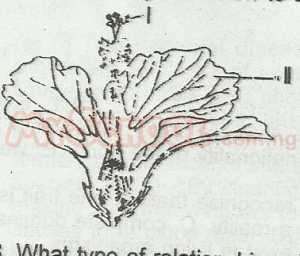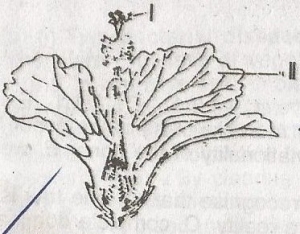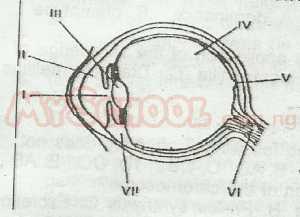Year :
1993
Title :
Biology
Exam :
WASSCE/WAEC MAY/JUNE
Paper 1 | Objectives
21 - 30 of 58 Questions
| # | Question | Ans |
|---|---|---|
| 21. |
Which of the following is not a courtship behaviour exhibited of animals? A. Pairing B. Display C. Seasonal migration D. Hibernation E. Territorialism. |
D |
| 22. |
Which of the following mineral salts is a trace element? A. Zinc B. CArbon C. Hydrogen D. Potassium E. Calcium |
A |
| 23. |
Which of the following organisms reduces nitrates in the soil to gaseous nitrogen? A. Euglena B. Protozoan C. Denitrifying bacterium D. Parasitic mould E. Nitrifying bacterium |
C |
| 24. |
The process whereby microorganisms can convert atmospheric nitrogen into nitrogenous compound is A. nitrogen cycle B. nitrogen fixation C. denitrification D. putrefaction E. decomposition |
B |
| 25. |
 What is the function of the part labelled ll? A. Attraction of insects B. Secretion of nectar C. Protection of the stigma D. Formation of fruit wall E. Attachment of flower to the shoot. |
A |
| 26. |
 The function of the part labelled l is to A. receive pollen grains B. produce nectar C. store the pollen grains D. store the ovules E. produce the male gametes |
A |
| 27. |
 How would you describe the position of the ovary in relation to the A. Superior B. lnferior C. Semi-inferior D. Gamosepalous E. Polysepalous |
A |
| 28. |
 The parts labelled IV, V and VI respectively are the A. ciliary body, optic nerve and yellow spot B. blind spot, optic nerve and suspensory ligament C. vitreous humour, yellow spot and optic nerve D. blind spot, optic nerve and pupil E. yellow spot, retina and choroid layer |
C |
| 29. |
 The light ray entering the eye goes through the following route A. II, III, I, IV, V B. II, I, VII, III C. II, I, III, IV D. V, VI, III, I E. I, VII, III, IV, V |
C |
| 30. |
 Which of the following structures are adjusted in focusing the image of a A. I and II B. II and III C. III and VII D. IV and V E. V and VII |
C |
| 21. |
Which of the following is not a courtship behaviour exhibited of animals? A. Pairing B. Display C. Seasonal migration D. Hibernation E. Territorialism. |
D |
| 22. |
Which of the following mineral salts is a trace element? A. Zinc B. CArbon C. Hydrogen D. Potassium E. Calcium |
A |
| 23. |
Which of the following organisms reduces nitrates in the soil to gaseous nitrogen? A. Euglena B. Protozoan C. Denitrifying bacterium D. Parasitic mould E. Nitrifying bacterium |
C |
| 24. |
The process whereby microorganisms can convert atmospheric nitrogen into nitrogenous compound is A. nitrogen cycle B. nitrogen fixation C. denitrification D. putrefaction E. decomposition |
B |
| 25. |
 What is the function of the part labelled ll? A. Attraction of insects B. Secretion of nectar C. Protection of the stigma D. Formation of fruit wall E. Attachment of flower to the shoot. |
A |
| 26. |
 The function of the part labelled l is to A. receive pollen grains B. produce nectar C. store the pollen grains D. store the ovules E. produce the male gametes |
A |
| 27. |
 How would you describe the position of the ovary in relation to the A. Superior B. lnferior C. Semi-inferior D. Gamosepalous E. Polysepalous |
A |
| 28. |
 The parts labelled IV, V and VI respectively are the A. ciliary body, optic nerve and yellow spot B. blind spot, optic nerve and suspensory ligament C. vitreous humour, yellow spot and optic nerve D. blind spot, optic nerve and pupil E. yellow spot, retina and choroid layer |
C |
| 29. |
 The light ray entering the eye goes through the following route A. II, III, I, IV, V B. II, I, VII, III C. II, I, III, IV D. V, VI, III, I E. I, VII, III, IV, V |
C |
| 30. |
 Which of the following structures are adjusted in focusing the image of a A. I and II B. II and III C. III and VII D. IV and V E. V and VII |
C |